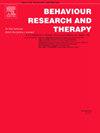When emotions persist: Emotional inertia predicts adolescent depression amid COVID-19 stress
IF 4.5
2区 心理学
Q1 PSYCHOLOGY, CLINICAL
引用次数: 0
Abstract
Emotional inertia—the extent to which emotional states persist over time—has been identified as a risk factor for depression. However, longitudinal evidence from real-world chronic stress remains limited. Leveraging the COVID-19 pandemic as a naturalistic stressor, this study examined: (a) how emotional inertia changed across distinct phases of the pandemic, and (b) how changes in positive versus negative emotional inertia related to depression risk. A total of 140 adolescents (Mage = 11.91, 47.9 % girls) completed ecological momentary assessments across three stress phases: pre-pandemic (one year before pandemic onset), acute pandemic, and chronic pandemic (one year after pandemic onset), yielding 7465 observations. Hypotheses and data analyses were preregistered. Latent change score modeling showed that both positive and negative emotional inertia increased from pre-pandemic to acute pandemic, then decreased from acute to chronic pandemic. However, positive and negative emotional inertia showed distinct associations with depressive symptoms. Increases in positive emotional inertia associated with fewer depressive symptoms at Wave 3, whereas increases in negative emotional inertia associated with more depressive symptoms at Wave 3. These associations remained significant even after controlling for baseline (Wave 1) depressive symptoms. These findings suggest that persistent negative emotions may amplify vulnerability, while stable positive emotions confer resilience in the face of stress. Emotional inertia may thus serve as a key marker of stress reactivity and an early intervention target for youth mental health.
当情绪持续时:情绪惯性预测青少年在COVID-19压力下的抑郁
情绪惯性——情绪状态持续一段时间的程度——已被确定为抑郁症的一个风险因素。然而,来自现实世界慢性压力的纵向证据仍然有限。本研究利用COVID-19大流行作为自然压力源,研究了:(a)情绪惯性在大流行的不同阶段如何变化,以及(b)积极和消极情绪惯性的变化如何与抑郁风险相关。共有140名青少年(年龄为11.91,其中47.9%为女孩)完成了三个应激阶段的生态瞬时评估:大流行前(大流行发病前一年)、急性大流行和慢性大流行(大流行发病后一年),得出7465项观察结果。假设和数据分析是预先登记的。潜在变化评分模型显示,从大流行前到急性大流行,积极和消极情绪惯性均呈上升趋势,从急性大流行到慢性大流行均呈下降趋势。然而,积极和消极的情绪惯性与抑郁症状有明显的联系。在第三波中,积极情绪惯性的增加与抑郁症状的减少有关,而在第三波中,消极情绪惯性的增加与抑郁症状的增加有关。即使在控制了基线(第一波)抑郁症状后,这些关联仍然显著。这些发现表明,持续的负面情绪可能会放大脆弱性,而稳定的积极情绪会在面对压力时赋予弹性。因此,情绪惯性可能是应激反应的关键标志,也是青少年心理健康的早期干预目标。
本文章由计算机程序翻译,如有差异,请以英文原文为准。
求助全文
约1分钟内获得全文
求助全文
来源期刊

Behaviour Research and Therapy
PSYCHOLOGY, CLINICAL-
CiteScore
7.50
自引率
7.30%
发文量
148
期刊介绍:
The major focus of Behaviour Research and Therapy is an experimental psychopathology approach to understanding emotional and behavioral disorders and their prevention and treatment, using cognitive, behavioral, and psychophysiological (including neural) methods and models. This includes laboratory-based experimental studies with healthy, at risk and subclinical individuals that inform clinical application as well as studies with clinically severe samples. The following types of submissions are encouraged: theoretical reviews of mechanisms that contribute to psychopathology and that offer new treatment targets; tests of novel, mechanistically focused psychological interventions, especially ones that include theory-driven or experimentally-derived predictors, moderators and mediators; and innovations in dissemination and implementation of evidence-based practices into clinical practice in psychology and associated fields, especially those that target underlying mechanisms or focus on novel approaches to treatment delivery. In addition to traditional psychological disorders, the scope of the journal includes behavioural medicine (e.g., chronic pain). The journal will not consider manuscripts dealing primarily with measurement, psychometric analyses, and personality assessment.
 求助内容:
求助内容: 应助结果提醒方式:
应助结果提醒方式:


